Pump Handbook by Igor J. Karassik, Joseph P. Messina, Paul Cooper, Charles C. Heald - 3rd edition
Подождите немного. Документ загружается.

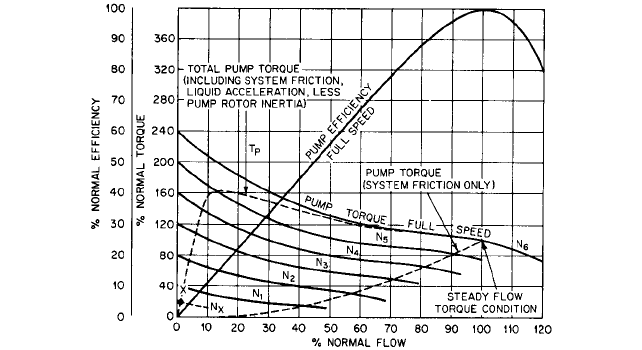
8.24 CHAPTER EIGHT
FIGURE 25 Transient total pump torque as a result of liquid acceleration and system friction when a propeller
pump is started with an open valve. Pump head characteristics are shown in Figure 24.
which is adjusted for different assumed conditions. Figure 26 shows a typical squirrel-
cage induction motor speed-torque curve, and, for the purpose of illustration, it has been
selected to have the same torque rating as the pump requires at full speed (approxi-
mately 97% synchronous speed). Point X in this figure is the motor torque at the average
speed during the first incremental speed change. In Figure 26, the developed torque curve
for the different speeds shown in Figure 25 is redrawn as the total frictional and inertial
pump torque T
p
. For the conditions used in this example, and as shown in Figure 26, after
approximately 88% synchronous speed, very little excess torque (T
D
T
p
) is available for
accelerating the pump and motor rotor inertia. However, as long as an induction motor
has adequate torque to drive the pump at the normal condition, full speed will be reached
providing the time-current demand can be tolerated. A synchronous motor, on the other
hand, may not have sufficient torque to pull into step. Liquid acceleration decreases as
motor torque decreases, adjusting to the available excess motor torque. The pump speed
changes very slowly during the final period. Figure 26 also shows the motor current for
the different speeds and torques.
A motor having a higher than normal pump torque rating or a motor having high
starting torque characteristics will reduce the starting time, but higher heads will be
produced during the acceleration period. Note, however, that heads produced cannot
exceed shutoff at any speed. The total torque input to the pump shaft is equal to the sum
of the torques required to overcome system friction, liquid inertia, and pump rotor iner-
tia during acceleration. Torque at the pump shaft will therefore follow the motor speed-
torque curve less the torque required to overcome the motor’s rotor inertia.To reduce the
starting inertial pump head to an acceptable amount, if desired, other alternative start-
ing schemes can be used. A short bypass line from the pump discharge back to the suc-
tion can be provided to divert flow from the main system. The bypass valve is closed
slowly after the motor reaches full speed. A variable-speed or a two-speed motor will
reduce the inertial head by controlling motor torque and speed, thereby increasing the
accelerating time.
This procedure for developing the actual system head and pump torque, including liq-
uid inertia, becomes more complex if the pump must employ a discharge valve. To avoid
high pump starting heads and torques, the discharge valve must be partially open on
starting and then opened a sufficient amount before full speed is reached. The valve resis-
tance must be added to the system friction and inertia curves if an exact solution is
required.
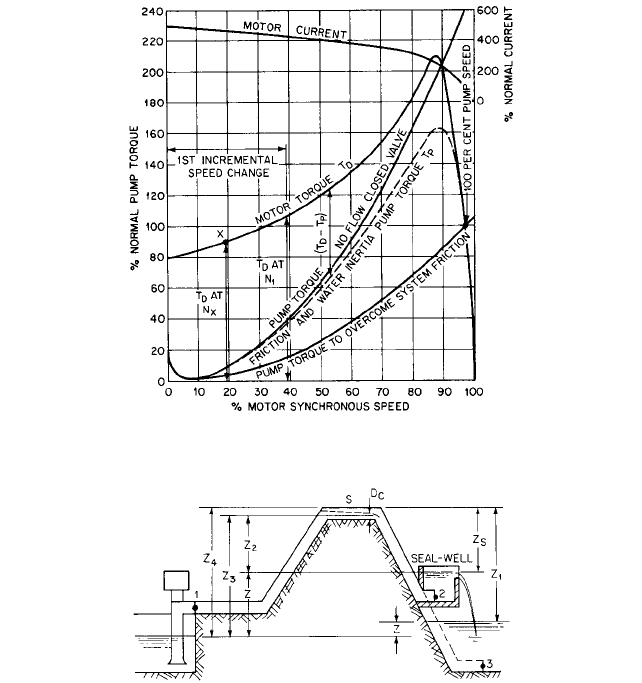
8.1 PUMPING SYSTEMS AND SYSTEM-HEAD CURRVES 8.25
FIGURE 26 Propeller pump and motor speed-torque curves, showing effect of accelerating the liquid in the
system during the starting period
FIGURE 27 Pumping system using a siphon for head recovery
Siphon Head Between any two points having the same elevation in a pumping system,
no head is lost because of piping elevation changes because the net change in elevation is
zero. If the net change in elevation between two points is not zero, additional pump head
is required if there is an increase in elevation and less head is required if there is a
decrease in elevation.
When piping is laid over and under obstacles with no net change in elevation, no pump-
ing head is required to sustain flow other than that needed to overcome frictional and minor
losses. As the piping rises, the liquid pressure head is transformed to elevation head, and
the reverse takes place as the piping falls.A pipe or other closed conduit that rises and falls
is called a siphon, and one that falls and rises is called an inverted siphon. The siphon prin-
ciple is valid provided the conduit flows full and free of liquid vapor and air so the densities
of the liquid columns are alike. It is this requirement that determines the limiting height
of a siphon for complete recovery because the liquid can vaporize under certain conditions.
Pressure in a siphon is minimum at the summit, or just downstream from it, and
Bernoulli’s equation can be used to determine if the liquid pressure is above or below
vapor pressure. Referring to Figure 27, observe the following. The absolute pressure head
H
s
in feet (meters) at the top of the siphon is
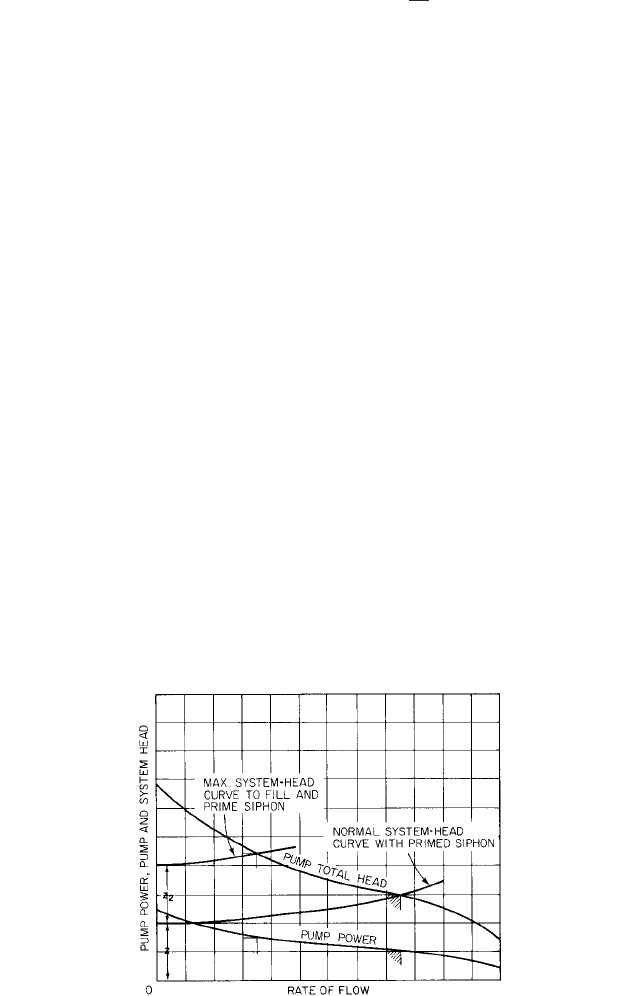
8.26 CHAPTER EIGHT
FIGURE 28 Transient system total head priming a siphon
(12)
where H
B
barometric pressure head of liquid pumped, ft (m)
Z
S
siphon height to top of conduit ( Z
1
if no seal well is used), ft (m)
h
f (s 2)
frictional and minor losses from S to 2 (or 3 if no seal well is used), includ-
ing exit velocity head loss at 2 (or 3), ft (m)
V
2
S
/2g velocity head at summit, ft (m)
The absolute pressure head at the summit can also be calculated using conditions in
the up leg by adding the barometric pressure head to the pump head (TH) and deducting
the distance from suction level to the top of the conduit (Z
4
), the frictional loss in the up
leg (h
f (1 S)
), and the velocity head at the summit. If the suction level is higher than the dis-
charge level and flow is by gravity, the absolute pressure head at the summit is found as
above and TH 0.
Whenever Z
1
in Figure 27 is so high that it exceeds the maximum siphon capability, a
seal well is necessary to increase the pressure at the top of the siphon above vapor pres-
sure. Note Z
1
Z
S
represents an unrecoverable head and increases the pumping head.
Water has a vapor pressure of 0.77 ft (23.5 cm) at 68°F (20°C) and theoretically a 33.23-ft-
high (10.13-cm) siphon is possible with a 34-ft (10.36-m) water barometer. In practice,
higher water temperatures and lower barometric pressures limit the height of siphons
used in condenser cooling water systems to 26 to 28 ft (8 to 8.5 m). The siphon height can
be found by using Eq. 12 and letting H
S
equal the vapor pressure in feet (meters).
In addition to recovering head in systems such as condenser cooling water, thermal
dilution, and levees, siphons are also used to prevent reverse flow after pumping is stopped
by use of an automatic vacuum breaker located in the summit. Often siphons are used
solely to eliminate the need for valves or flap gates.
In open-ended pumping systems, siphons can be primed by external means of air
removal. Unless the siphon is primed initially upon starting, a pump must fill the sys-
tem and provide a minimum flow to induce siphon action. During this filling period and
until the siphon is primed, the siphon head curve must include this additional siphon
filling head, which must be provided by the pump. Pumps in siphon systems are usually
low-head, and they may not be capable of filling the system to the top of the siphon or
of filling it with adequate flow. Low-head pumps are high-specific-speed and require
more power at reduced flows than during normal pumping. Figure 28 illustrates the
performance of a typical propeller pump when priming a siphon system and during nor-
mal operation.
H
S
H
B
Z
S
h
f 1S22
V
2
S
2g

8.1 PUMPING SYSTEMS AND SYSTEM-HEAD CURRVES 8.27
TABLE 1 Values for determining pipe-diameter ratio versus (ft
3
/s)/d
5/2
in circular
pipes
0.00 0.01 0.02 0.03 0.04 0.05 0.06 0.07 0.08 0.09
0.0 . . . 0.0006 0.0025 0.0055 0.0098 0.0153 0.0220 0.0298 0.0389 0.0491
0.1 0.0605 0.0731 0.0868 0.1016 0.1176 0.1347 0.1530 0.1724 0.1928 0.2144
0.2 0.2371 0.2609 0.2857 0.3116 0.3386 0.3666 0.3957 0.4259 0.4571 0.4893
0.3 0.523 0.557 0.592 0.628 0.666 0.704 0.743 0.784 0.825 0.867
0.4 0.910 0.955 1.000 1.046 1.093 1.141 1.190 1.240 1.291 1.343
0.5 1.396 1.449 1.504 1.560 1.616 1.674 1.733 1.792 1.853 1.915
0.6 1.977 2.041 2.106 2.172 2.239 2.307 2.376 2.446 2.518 2.591
0.7 2.666 2.741 2.819 2.898 2.978 3.061 3.145 3.231 3.320 3.411
0.8 3.505 3.602 3.702 3.806 3.914 4.023 4.147 4.272 4.406 4.549
0.9 4.70 4.87 5.06 5.27 5.52 5.81 6.18 6.67 7.41 8.83
All tabulated values are in units of (ft
3
/s)/d
5/2
; d diameter, ft; D
crit
critical depth, ft. For SI
units, multiply (m
3
/h)/m
5/2
by 5.03 10
4
to obtain (ft
3
/s)/ft
5/2
. Examples 2, 3, and 4 illustrate the use
of this table.
Source: Reference 13.
D
crit
d
When a pump and driver are to be selected to prime a siphon system, it is necessary to
estimate the pump head and the power required to produce the minimum flow needed to
start the siphon.
The minimum flow required increases with the length and the diameter and decreases
with the slope of the down-leg pipe.
2
Prior to the removal of all the air in the system, the
pump is required to provide head to raise the liquid up to and over the siphon crest. Head
above the crest is required to produce a minimum flow similar to flow over a broad-crested
weir. This weir head may be an appreciable part of the total pump head if the pump is low-
head and large-capacity. A conservative estimate of the pump head would include a full
conduit above the siphon crest. In reality, the down leg must flow partially empty before it
can flow full, and it is accurate enough to estimate that the depth of liquid above the
siphon crest is at critical depth for the cross section. Table 1 can be used to estimate criti-
cal depth in circular pipes, and Figure 29 can be used to calculate the cross-sectional area
of the filled pipe to determine the velocity at the siphon crest.
Until all the air is removed and all the piping becomes filled, the down leg is not part
of the pumping system, and its frictional and minor losses are not to be added to the max-
imum system-head curve to fill and prime the siphon shown in Figure 28. The total head
TH in feet (meters) to be produced by the pump in Figure 27 until the siphon is primed is
(13)
where Z
3
distance between suction level and centerline liquid at siphon crest, ft (m)
h
f(1 s)
frictional and minor losses from 1 to S, ft (m)
V
2
C
/2g velocity head at crest using actual liquid depth, approx. critical depth, ft (m)
Use of Eq. 13 permits plotting the maximum system-head curve to fill and prime the
siphon for different flow rates.The pump priming flow is the intersection of the pump total
head curve and this system-head curve.The pump selected must have a driver with power
as shown in Figure 28 to prime the system during this transient condition.
For the pumping system shown in Figure 27, after the system is primed, the pump
total head reduces to
(14)TH Z h
f1122
TH Z
3
h
f 11S2
V
2
C
2g
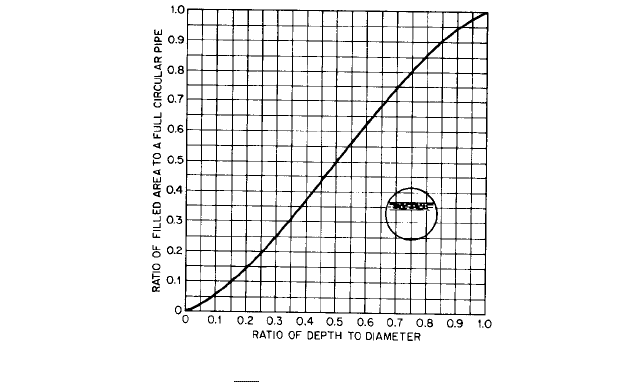
8.28 CHAPTER EIGHT
FIGURE 29 Area versus depth for a circular pipe
In SI units:
1 meter 3.28 feet
1 VD (V in m/s, D in m) 129.2 VD" (V in ft/s, D" in inches)
R
rVD
m
1r in kg> m
3
, V in m>s, D in m, m in Ns>m
2
2
where Z distance between suction and seal well levels (or discharge pool level if no
seal well is used), ft (m)
h
f(12)
frictional and minor losses from 1 to 2 (or 3 if no seal well is used), includ-
ing exit velocity head loss at 2 (or 3), ft (m)
Use of Eq. 14 permits plotting of the normal system-head curve with a primed siphon,
shown in Figure 28, for different flow rates. The normal pump flow is the intersection of
the pump total head curve and the normal system-head curve.
If the pump cannot provide sufficient flow to prime the siphon, or if the driver does not
have adequate power, the system must be primed externally by a vacuum or jet pump. An
auxiliary priming pump can also be used to continuously vent the system because it is
necessary that this be done to maintain full siphon recovery. In some systems, the water
pumped is saturated with air, and as the liquid flows through the system, the pressure is
reduced (and in cooling systems the temperature is increased). Both these conditions
cause the release of some of the entrained air. Air will accumulate at the top of the siphon
and in the upper parts of the down leg.The siphon works on the principle that an increase
in elevation in the up leg produces a decrease in pressure and an equal decrease in ele-
vation in the down leg resulting in recovery of this pressure.This cannot occur if the den-
sity of the liquid in the down leg is decreased as a result of the formation of air pockets.
These air pockets also restrict the flow area. A release of entrained air and air leakage
into the system through pipe joints and fittings will result in a centrifugal pump’s deliv-
ering less than design flow, as the head will be higher than estimated.Also, high-specific-
speed pumps with rising power curves toward shutoff can become overloaded. In order to
maintain full head recovery, it is necessary to continuously vent the siphon at the top and
at several points along the down leg, especially at the beginning of a change in slope.
3
These venting points can be manifolded together and connected to a single downward
venting system.
Some piping systems may contain several up and down legs; that is, several siphons in
series. Each down leg, as in a single siphon, is vulnerable to air or vapor binding. The like-
lihood of flow reduction, and conceivably in some cases complete flow shutoff, is increased
in a multiple siphon system.
3
As shown in Figure 30, system static head is increased if
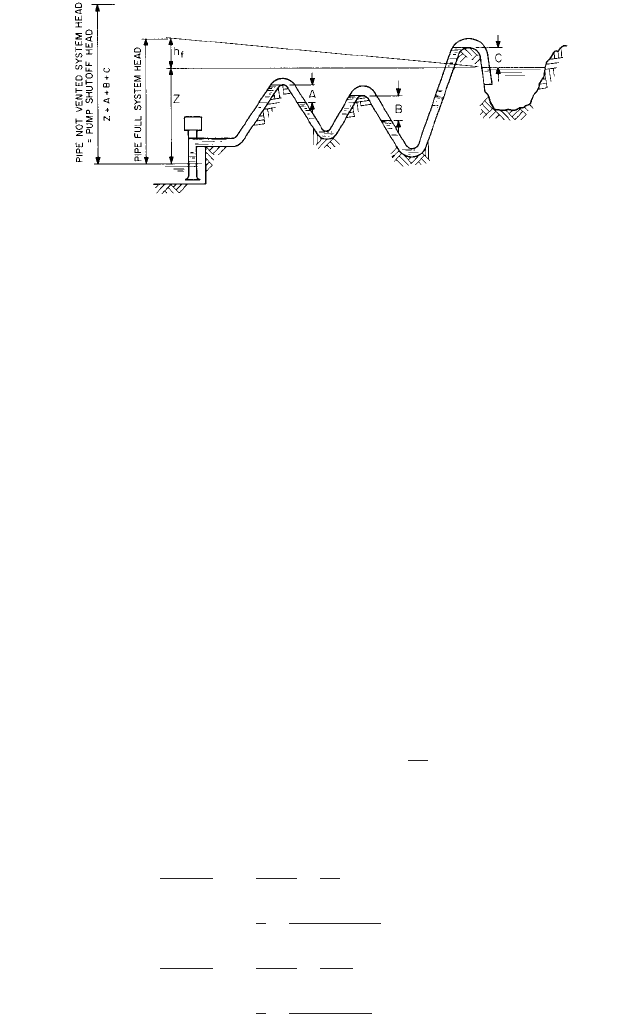
8.1 PUMPING SYSTEMS AND SYSTEM-HEAD CURRVES 8.29
FIGURE 30 Multiple siphon system (Z normal system static head when pipe is flowing full). Pump flow is
stopped when normal static head plus sum of air pocket heights equals pump shutoff head.
proper venting is not provided at the top of each siphon. Normally the static head is the dif-
ference between outlet and inlet elevations. If air pockets exist, head cannot be recovered
and the normal static head is increased by the sum of the heights of all the intermediate
liquidless pockets. Flow will stop when the total static head equals the pump shutoff head.
The following examples illustrate the use of Eqs. 3, 9, 12, 13, and 14,Table 1, and Figure 29.
EXAMPLE 2 A pump is required to produce a flow of 70,000 gpm (15,900 m
3
/h) through
the system shown in Figure 27. Calculate the system total head from point 1 to point
3 (no seal well) under the following conditions:
Specific gravity 0.998 for 80°F (26.7°C) water
Barometric pressure 29 in (73.7 cm) mercury abs (sp. gr. 13.6)
Suction and discharge water levels are equal, Z 0
Z
1
40 ft (12.2 m)
Hf
(1s)
3 ft (0.91 m) up-leg frictional head
h
f(S3)
3.3 ft (1 m) down-leg frictional head, including exit loss
Pipe diameter 48 in (121.9 cm) ID
Water vapor pressure 0.507 lb/in
2
(3.5 kPa) abs at 80°F (26.7°C)
The maximum siphon height may be found from Eq. 12:
From Eq. 3
H
B
barometric pressure head in feet (meters) of liquid pumped
In USCS units
In SI units
H
S
p
g
3.5 1000
9769
0.358 m abs
sp. gr.
1
sp. gr.
2
h
1
13.6
0.998
73.7
100
10 m abs
H
S
p
g
144 0.507
62.19
1.17 ft abs
sp. gr.
1
sp. gr.
2
h
1
13.6
0.998
29
12
32.9 ft abs
Z
S
H
B
h
f 1S32
H
S
V
2
S
2g

8.30 CHAPTER EIGHT
From Eqs. 9 and 12,
in USCS units
in SI units
Because the maximum height is exceeded (Z
1
Z
s
), siphon recovery is not possible.
The system total head is therefore found from Eq. 13:
The critical depth D
crit
is found using Table 1:
In USCS units
In SI units
Convert to USCS units (see footnote to Table 1):
To calculate the water velocity at the siphon crest, determine the area of the filled pipe.
From Figure 29, ratio of filled area to area of a full pipe is 0.95 for a depth-to-diameter
ratio of 0.901:
In USCS units
From Eq. 13
In SI units V
c
m
3
>h
0.951ID in cm2
2
3.54
15,900
0.95 121.9
2
3.54 3.99 m>s
TH 37.8 3
13.0
2
2 32.17
43.43 ft
Z
3
40 4
3.6
2
37.8 ft
V
c
gpm
0.951ID in inches2
2
0.408
70,000
0.95 48
2
0.408 13.0 ft>s
D
crit
0.901 1.219 1.1 m
D
crit
d
0.901
ft
3
>s
ft
5>2
9695 5.03 10
4
4.88
m
3
>h
d
5>2
15,900
1.219
5>2
9695
D
crit
0.901 4 3.6 ft
D
crit
d
0.901
ft
3
>s
d
5>2
156
4
5>2
4.88
ft
3
>s
70,000
7.481 60
156
TH Z
3
h
f 11S2
V
2
c
2g
Z
S
10 1 0.358
3.79
2
2 9.807
9.1 m
V
S
m
3
>h
1pipe ID in cm2
2
3.54
15,900
121.9
2
3.54 3.79 m>s
Z
S
32.9 3.3 1.17
12.4
2
2 32.17
32.63 ft
V
S
gpm
1pipe ID in inches2
2
0.408
70,000
48
2
0.408 12.4 ft>s

8.1 PUMPING SYSTEMS AND SYSTEM-HEAD CURRVES 8.31
From Eq. 13
EXAMPLE 3 Calculate the minimum total system head using conditions in Example 2
and a seal well, as shown in Figure 27. Use 2.8 ft (0.853 m) for the frictional head loss
h
f(s2)
.
The maximum siphon height Z
s
in Example 2 was found to be 32.63 ft (9.95 m).
Therefore from Eq. 14 the total system head after priming is
In USCS units
In SI units
Note that the seal well elevation is above discharge level. Therefore
in USCS units
in SI units
EXAMPLE 4 The dimensions of the down leg in Example 3 require a minimum velocity
of 5 ft/s (1.52 m/s) flowing full to purge air from the system and start the siphon. Cal-
culate the system head the pump must overcome to prime the siphon.
In USCS units
In SI units
The critical depth is found from Table 1:
In USCS units
In SI units
Convert to USCS units (see footnote to Table 1):
D
crit
0.6 1.219 0.73 m
D
crit
d
0.6
ft
3
>s
d
5>2
3902 5.03 10
4
1.97
m
3
>h
d
5>2
6400
1.219
5>2
3902
D
crit
0.6 4 2.4 ft
D
crit
d
0.6
ft
3
>s
d
5>2
62.8
4
5>2
1.97
m
3
>h
V1pipe ID in cm2
2
3.54
1.52 121.9
2
3.54
6400
ft
3
>s 28,200 449 62.8
gpm
V1pipe ID in inches2
2
0.408
5 48
2
0.408
28,200
TH 2.25 1.763 4.01 m
TH 7.37 5.8 13.17 ft
Z Z
1
Z
S
12.2 9.95 2.25 m
h
f1122
h
f11S2
h
f1S22
0.91 0.853 1.763 ft
Z Z
1
Z
S
40 32.63 7.37 ft
h
f1122
h
f11S2
h
f1S22
3 2.8 5.8 ft
TH Z h
f1122
TH 11.53 0.91
3.99
2
2 9.807
13.25 m
Z
3
12.2 1.219
1.1
2
11.53 m

8.32 CHAPTER EIGHT
From Figure 29, the ratio of the filled area to the area of a full pipe is 0.625 for a depth-
to-diameter ratio of 0.60:
In USCS units
In SI units
From Eq. 13
In USCS units
In SI units
If the system is not externally primed, the centrifugal pump selected must be able
to deliver at least 28,000 gpm (6400 m
3
/h) at 38.68 ft (11.79 m) total head and must be
provided with a driver having adequate power for this condition. After the system is
primed, the pump must be capable of delivering at least 70,000 gpm (15,900 m
3
/h) at
13.17 ft (4.01 m) (see Figure 28).
HEAD LOSSES IN SYSTEM COMPONENTS_______________________________
Pressure Pipes
Resistance to flow through a pipe is caused by viscous shear stresses
in the liquid and by turbulence at the pipe walls. Laminar flow occurs in a pipe when the
average velocity is relatively low and the energy head is lost mainly as a result of viscos-
ity. In laminar flow, liquid particles have no motion next to the pipe walls and flow occurs
as a result of the movement of particles in parallel lines with velocity increasing toward
the center. The movement of concentric cylinders past each other causes viscous shear
stresses, more commonly called friction. As flow increases, the flow pattern changes, the
average velocity becomes more uniform, and there is less viscous shear. As the laminar
film decreases in thickness at the pipe walls and as the flow increases, the pipe rough-
ness becomes important because it causes turbulence. Turbulent flow occurs when aver-
age pipe velocity is relatively high and energy head is lost predominantly because of
turbulence caused by the wall roughness. The average velocity at which the flow changes
from laminar to turbulent is not definite, and there is a critical zone in which either lam-
inar or turbulent flow can occur.
Viscosity can be visualized as follows. If the space between two planar surfaces is filled
with a liquid, a force will be required to move one surface at a constant velocity relative to
the other. The velocity of the liquid will vary linearly between the surfaces.The ratio of the
force per unit area, called shear stress, to the velocity per unit distance between surfaces,
called shear or deformation rate, is a measure of a liquid’s dynamic or absolute viscosity.
TH 12.25 9.12 0.15
2.4
2
2 9.807
11.79 m
h
f11S2
at 6400 m
3
>h a
6400
15,900
b
2
0.91 0.15 m
Z 2.25 m 1from Example 32
Z
2
Z
S
1.219
D
crit
2
9.95 1.219
0.73
2
9.1 m
TH 17.37 29.832 0.49
8
2
2 32.17
38.68 ft
h
f 11 S2
at 28,200 gpm a
28,200
70,000
b
2
3 0.49 ft
Z 7.37 ft 1from Example 32
Z
2
Z
S
4
D
crit
2
32.63 4
2.4
2
29.83 ft
TH Z
3
h
f11S2
V
c
2
2g
V
c
1.52
0.625
2.4 m>s
V
c
5
0.625
8.0 ft>s

8.1 PUMPING SYSTEMS AND SYSTEM-HEAD CURRVES 8.33
Liquids such as water and mineral oil, which exhibit shear stresses proportional to
shear rates, have a constant viscosity for a particular temperature and pressure and are
called Newtonian or true liquids. In the normal pumping range, however, the viscosity of
true liquids may be considered independent of pressure. For these liquids, the viscosity
remains constant because the rate of deformation is directly proportional to the shearing
stress.The viscosity and resistance to flow, however, increase with decreasing temperature.
Liquids such as molasses, grease, starch, paint, asphalt, and tar behave differently
from Newtonian liquids. The viscosity of the former does not remain constant and their
shear, or deformation, rate increases more than the stress increases. These liquids, called
thixotropic, exhibit lower viscosity as they are agitated at a constant temperature.
Still other liquids, such as mineral slurries, show an increase in viscosity as the shear
rate is increased and are called dilatant.
In USCS units, dynamic (absolute) viscosity is measured in pound-seconds per square
foot or slugs per foot-second. In SI measure, the units are newton-seconds per square
meter or pascal-seconds. Usually dynamic viscosity is measured in poises (1 P 0.1 Pa s)
or in centipoises (1 cP P):
The viscous property of a liquid is also sometimes expressed as kinematic viscosity.
This is the dynamic viscosity divided by the mass density (specific weight/g). In USCS
units, kinematic viscosity is measured in square feet per second. In SI measure, the units
are square meters per second. Usually kinematic viscosity is measured in stokes (1 St
0.0001 m
2
/s) or in centistokes (1 cSt St):
A common unit of kinematic viscosity in the United States is Saybolt seconds univer-
sal (SSU) for liquids of medium viscosity and Saybolt seconds Furol (SSF) for liquids of
high viscosity. Viscosities measured in these units are determined by using an instrument
that measures the length of time needed to discharge a standard volume of the sample.
Water at 60°F (15.6°C) has a kinematic viscosity of approximately 31 SSU (1.0 cSt). For
values of 70 cSt and above,
The dimensionless Reynolds number Re is used to describe the type of flow in a pipe
flowing full and can be expressed as follows:
(15)
where V average pipe velocity, ft/s (m/s)
D inside pipe diameter, ft (m)
y liquid kinematic viscosity, ft
2
/s (m
2
/s)
r liquid density, slugs/ft
3
(kg/m
3
)
m liquid dynamic (or absolute) viscosity slug/ft s (N s/m
2
)
Note: The dimensionless Reynolds number is the same in both USCS and SI units.
When the Reynolds number is 2000 or less, the flow is generally laminar, and when it is
greater than 4000, the flow is generally turbulent. The Reynolds number for the flow of
water in pipes is usually well above 4000, and therefore the flow is almost always turbulent.
The Darcy-Weisbach formula is the one most often used to calculate pipe friction. This
formula recognizes that friction increases with pipe wall roughness, with wetted surface
area, with velocity to a power, and with viscosity and decreases with pipe diameter to a
power and with density. Specifically, the frictional head loss h
f
in feet (meters) is
Re
VD
v
rVD
m
SSU 10 SSF
cSt 0.216 SSU
1 ft
2
>s 0.0929034 m
2
>s 92,903.4 cSt
1
100
1 lb
#
s>ft
2
47.8801 Pa
#
s 47,880.1 cP
1
100
